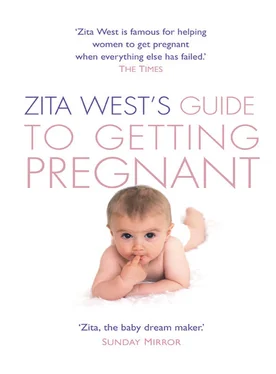1 ...6 7 8 10 11 12 ...19 Equally, an excess of oestrogen can be counter – productive to conception. But take heart: there are ways round these issues – we’ll be taking a look at them in the Nutrition chapter.
The rising oestrogen level makes the hypothalamus reduce the secretion of GnRH and FSH. As the FSH decreases, oestrogen levels from the maturing follicle rise abruptly. Only then will the pituitary gland secrete LH (luteinizing hormone), which allows just one mature follicle to release an egg – ovulation.
The ovum, or egg, is the largest cell in the body – 550 times bigger than the sperm. As it matures within its fluid – filled follicle prior to ovulation, it needs a lot of energy, which is supplied by the granulosa cells (specialized cells in the ovary). These cells have two functions: to secrete oestrogen (to help the egg mature) and to nourish and feed the egg as it grows.
The maturing egg is now suspended in a fluid – filled cavity (sometimes referred to as the graafian follicle, after the scientist who first discovered it). This follicle measures about 18–23mm just prior to ovulation, and when ovulation – the release of the egg – occurs, the follicle bursts and the mature egg is released into the Fallopian tube.
There are an estimated 7 million granulosa cells packed around an egg, greatly increasing the availability of energy. When the egg is eventually released, it takes with it a mass of these cells, giving it a ‘sunburst’ appearance. These cells also serve to protect and nourish the egg on its journey, and will provide a barrier against all but the one sperm that will fertilize it.
The hormonal stimulus for ovulation is the rise of oestrogen, and the primary factor that determines when you will ovulate is the level of oestrogen getting to a certain threshold, which creates a surge in luteinizing hormone (LH), responsible for the rupture of the follicle and release of the egg. So anything that depletes oestrogen will keep it from reaching the necessary level, and ovulation will not take place.
Ovulation also won’t occur unless the optimum level of oestrogen is maintained for the correct length of time. The timing of ovulation is quite exact, occurring about 36 hours after the surge in LH. Only a mature egg, once fertilized, will result in conception. Immature eggs are unlikely to be capable of being fertilized, and even if they are they tend to produce an abnormal embryo that won’t implant or develop properly, resulting in an early miscarriage (before 12 weeks). So it’s very important that the level of oestrogen produced accurately reflects the egg’s maturity. It’s a delicate feedback process, and the timing is crucial. A mature egg is necessary for fertilization because only then will it have chromosomes at the right stage for further development, allowing one sperm in and blocking the rest, and ensuring that the egg and sperm fuse properly.
At the same time, just before ovulation the follicle generates a rapid rise in the hormone progesterone. The rise in progesterone also keeps the FSH secretion going just long enough to allow full maturation of the follicle. As the hypothalamus is shutting down on FSH secretion, it is releasing prostaglandins to the follicle just before it ruptures. It is thought that these prostaglandins may help to expel the egg by breaking down the follicle wall.
Once the egg is released, the resulting cavity and the remaining granulosa cells start to produce more progesterone. These cells also stain the ruptured follicle an orangey – yellow colour, giving rise to the name corpus luteum , from the Latin for ‘yellow body’.
The egg is at its most susceptible to nutrient deficiency during this phase of the menstrual cycle, leading up to ovulation where the egg is maturing, and during early embryonic life (the first 30 days after conception). Research shows that a 70 per cent increase in sensitivity to toxins, alcohol and smoke occurs between 11.30 a.m. and 7 p.m. on the day preceding ovulation. In the five days prior to ovulation a good diet and as few toxins as possible are particularly important for achieving pregnancy. Also, it is not wise to drink heavily during this phase of your cycle. If the diet is too low in proteins, for example, too few eggs may ripen, while a vitamin B1 deficiency can inhibit ovulation. Because it can be difficult to gauge exactly when ovulation occurs, however, it is always wise to maintain good nutrition throughout your cycle.
Having managed to ovulate a mature, functioning egg and, with all other things working to advantage, the lifespan of the egg is only estimated to be around 8 to 12 hours. This is further complicated by the difficulty in knowing exactly when ovulation occurs. For example, if you ovulate at 3 a.m. but don’t have intercourse until the following evening, chances are that the egg is no longer capable of being fertilized. Now, I wouldn’t want any woman reading this to start lying awake at night worrying that she might be ovulating then and there – this won’t help you or your partner in the long run! – but this is why regular and frequent sex is an essential feature of successful conception. Keep in mind that sperm deposited in a woman’s vagina stay alive, on average, for between two and three days (and in some cases for up to a week), so if you are having sex every day or every couple of days around the most fertile time of your cycle, the chances of conception are increased dramatically. Research shows that most pregnancies occur within a ‘fertile window’ of six days before ovulation and one day after. If there are live, potent sperm in the Fallopian tubes when ovulation occurs, then conception is much more likely than if sex occurs sometime after ovulation.
The length of the menstrual cycle is measured from the first day of menstruation (first day of fresh bleeding) up to the day before the next period starts. The time you are fertile will vary according to the length of your cycle. The time from ovulation to the next period is likely to be constant – approximately 10 to 16 days – whereas the time before you ovulate can be more variable.
The fertile time in a woman’s cycle is identified by two different approaches:
1. by looking at the length of your cycle and making calculations based on observing your secretions (see page 22)
2. by a combination of recording your temperature and knowing the position of your cervix (see page 22) – though I don’t usually encourage women to use these measures, as trying to do so can be confusing and stressful.
Understanding that the post – ovulation phase remains constant at around 14 days, while the pre – ovulation phase is the one that’s variable, is essential because this will help you to work out, roughly, when you are ovulating. Once you have a rough idea of what’s normal for you, working out the other indicators of fertility becomes easier.
Only if a woman’s cycle is a regular 28 days does she ovulate mid – cycle, around day 14. If her regular cycle is 25 days, then ovulation occurs around day 11; a cycle of 35 days means ovulation around day 21; and for a very long cycle of 42 days, ovulation occurs around day 28.
Many women mistakenly believe that ovulation occurs ‘mid – cycle’, then wonder why they are getting their calculations wrong. Everywhere this myth continues to be perpetuated, and it can really hamper couples’ attempts to conceive. For example, if you thought the middle of your 35-day cycle was when you were ovulating, you’d think this was day 17 – when in fact, it’s day 21 – and would thereby make a crucial error when it came to timing sexual intercourse to coincide with your fertile time.
Читать дальше












